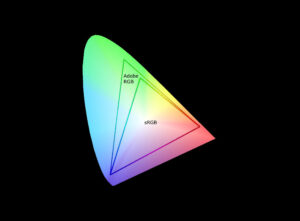Chances are, it is a resounding ‘No,’ you do not need to shoot Adobe RGB on your camera, and for most users it will actually badly affect the colour, output for screen and print, and compatibility of the images you are taking. You only need to use the Adobe RGB setting on your camera if you are recording JPEGs or TIFFs that will be converted to a CMYK colour space for press printing such as a newspaper or magazine. You only need to output an Adobe RGB image from your camera or editor if you are sending an image to a press print for a magazine, newspaper, or offset printer. If you have a mid to high end digital camera, or scanner you have probably seen the option to record pictures in Adobe RGB. It sounds more advanced doesn’t it? And looking at the colour diagram of Adobe RGB vs sRGB, it even looks like Adobe RGB records more colours than sRGB. It isn’t really true and the diagram is a bit misleading.
What is RGB/sRGB?
RGB stands for Red Green Blue, the 3 primary light colours that mix together to create the colours we see. sRGB is capable of recording all the colours we see, and often when viewed on a screen or printed on a consumer printer at home or at a consumer photolab looks great. sRGB is also perfect for editing in Adobe Lightroom or Photoshop.
So what is the point of Adobe RGB?
To understand the point of Adobe RGB, we need to understand that normally converting sRGB to CMYK causes colour shifts, especially with the more vibrant/saturated images. That is because RGB is an additive colour system, as you add more colour the image appears brighter (100% Red + 100% Green + 100% Blue = White light), but CMYK, which stands for Cyan Magenta Yellow Black (or Key) appears duller with every layer of ink. The more of each you add, the darker the colour gets until you end up with black.
Often converting sRGB to CMYK causes too many unwanted colour shifts. You can see these here when I’m changing the colour space of a file in Photoshop from RGB to CMYK.
Adobe RGB is an RGB format designed to more closely mimic the (duller) look of CMYK 4 colour printing on your screen when editing for the press, outputting and then avoiding unwanted visual shifts when you convert to CMYK.
If you are shooting RAW on your camera, it doesn’t matter what you select in the menu, the RAW data will be recorded and you get to choose if you output an sRGB or Adobe RGB image from your image editor like Lightroom.
If you have shot your image in RAW or DNG, you get to choose the output colour space when you convert your edited RAW to the delivery format, such as when you export from Adobe Lightroom. You only need to think about changing it in camera if you are saving your photos as JPEGs or TIFFs.
Adobe RGB
Adobe RGB, introduced by Adobe Systems, Inc. in 1998, stands as a comprehensive colour space renowned for its expansive gamut. In comparison to sRGB, Adobe RGB encompasses a broader range of green to red hues, making it particularly suitable for applications demanding high-fidelity colour reproduction.
Key Features of Adobe RGB
Extensive Colour Gamut
Adobe RGB offers a wider spectrum of colours, surpassing the limitations of conventional colour spaces.
Compatibility with Professional Tools
Widely supported by Adobe’s software ecosystem, including Adobe Photoshop, Adobe RGB facilitates precise colour management and editing workflows.
Print Industry Standard
This is possibly the most important point, and why Adobe RGB is irrelevant to most digital photographers. With coverage extending to ISO-Coated colour space, Adobe RGB finds extensive use in pre-press environments, ensuring seamless colour transitions from digital to print media.
sRGB
As the international standard for RGB colour space, sRGB holds widespread adoption across digital platforms and devices. Defined by the International Electrotechnical Commission (IEC), sRGB serves as the default colour space for web content, ensuring consistent colour rendering across various displays.
Key Features of sRGB
Universal Compatibility
sRGB compatibility extends across a multitude of devices, making it ideal for web content, social media, and general-purpose imaging.
Simplified Workflow
By adhering to a standardized colour profile, sRGB minimizes discrepancies in colour representation, ensuring uniformity across different viewing platforms.
Ease of Integration
sRGB seamlessly integrates into digital workflows, offering reliability and predictability in colour reproduction for both amateur and professional users.
Practical Considerations
When determining the appropriate colour space for specific applications, several factors come into play.
Image Output Destination
Consider the intended use of the images, whether for web display, print media, or professional publishing.
Editing Workflow
Assess the compatibility of colour spaces with editing software and workflow requirements.
Device Calibration
Ensure proper calibration of monitors and printers to accurately display and reproduce colours according to the selected colour space.

In the debate between Adobe RGB and sRGB, the choice ultimately depends on the specific needs and preferences of the user. While Adobe RGB offers a broader colour gamut tailored for professional applications such as pre-press and print production, sRGB remains the go-to option for general-purpose imaging and web-based content. By understanding the nuances of these colour spaces and their implications, users can make informed decisions to achieve optimal results in their digital imaging endeavours.







































































